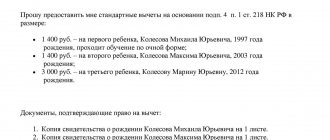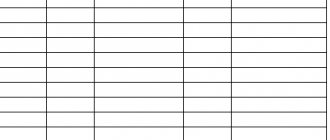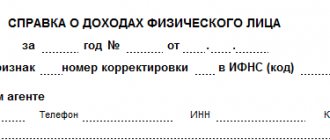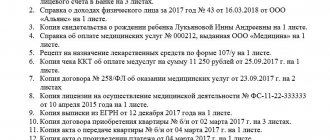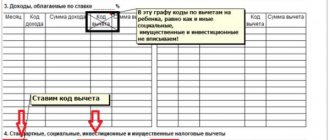A citizen who pays personal income tax at the regular rate of 13% has the right to use standard tax deductions provided for in Article 218 of the Tax Code of the Russian Federation (TC). By determining the base for income tax according to the rules of paragraph 3 of Article 210 of the Tax Code, a resident individual can reduce taxable income by the amount of the standard deduction. This preference allows you to minimize the amount of personal income tax transferred to the budget at the end of the tax period (year). To apply for such a benefit, the applicant must meet the requirements of Article 218 of the Tax Code and comply with the established procedure.
Child tax credit in 2021. Who can provide a deduction for children?
This benefit should be established for every employee who has children under the age of 18. If they are studying at a higher institution and have the status of cadets, graduate students, students, residents, then the period for obtaining benefits for them is extended to 24 years.
You must stop using the deduction starting from the month following the month you stop studying. True, in a situation with education there is an exception - if the child gets married. In addition, the deduction is accrued not only for the natural child, but also for those adopted or in care.
At its core, a deduction is an amount fixed by law by which the personal income tax base is reduced at a rate of 13%. All other incomes that fall under other rates (9%, 30%, etc.) are not subject to benefits.
The deduction is used incrementally from the beginning of the tax period (year). However, the Tax Code sets a limit on income received, after which the deduction ceases to be valid. In 2017, it did not change, and everything was also set in the amount of 350,000 rubles. This restriction means that from the month in which the employee’s earnings reached the specified amount, the benefit is canceled.
Attention! The Tax Code provides for the possibility for the second parent to double the benefits if the first parent is absent. This means death or recognition of him as missing. To receive a double benefit, you must provide documents confirming this status.
However, once a parent who was classified as single remarries, he or she automatically loses the double benefit. But if the marriage is dissolved again in the future, then you can again obtain the right to double benefits, but only under one condition - during the marriage, the child was not adopted by the second parent.
You can also renounce your benefit in favor of doubling it for the second parent. This opportunity can be used if one of the parents currently has no income. The one who makes the refusal must put it in writing, and also take a certificate from his workplace stating that he is not currently using the benefit.
However, it is impossible to issue a refusal in the following cases:
- The parent who wants to refuse is not employed at the time of refusal;
- Is on maternity leave or maternity leave;
- Registered with the employment center.
Attention! The accountant must be extremely careful when determining the right to benefits for divorced parents. They can only be provided in a situation where the parent actually participates in financing the child. For example, this can be confirmed by a document confirming the transfer of alimony.
To whom, when and how much
| Deduction amount | Deduction code | To whom is it provided? |
| 1400 | 126 | For the first child to the parent, spouse of the parent, adoptive parent, who provides support for the child |
| 130 | For the first child, the guardian, trustee, adoptive parent, spouse of the adoptive parent, who is providing for the child | |
| 127 | For the second child to the parent , spouse of the parent, adoptive parent, who is providing for the child | |
| 131 | For the second child, the guardian , trustee, adoptive parent, spouse of the adoptive parent, who is providing for the child | |
| 3000 | 128 | For the third and each subsequent child to the parent , spouse of the parent, adoptive parent, guardian, trustee, adoptive parent, spouse of the adoptive parent who is providing for the child |
| 132 | For the third and each subsequent child to the guardian , trustee, adoptive parent, spouse of the adoptive parent who is providing for the child | |
| 6000 | 133 | For each child, a guardian , trustee, foster parent, spouse of a foster parent who is providing for the child, if the child under 18 years of age is a disabled child , or a full-time student, graduate student, resident, intern, a student under the age of 24, if he is a disabled person of group I or II |
| 12000 | 129 | For each child a parent , a spouse of a parent, an adoptive parent, who is supporting the child, if the child under the age of 18 is a disabled child , or a full-time student, graduate student, resident, intern, student under the age of 24 years old if he is disabled group I or II |
| 2800 | 134 | Double the amount for the first child under the age of 18, as well as for each full-time student, graduate student, resident, intern, student, cadet under the age of 24 to a single parent , adoptive |
| 135 | Double the amount for the first child under the age of 18, as well as for each full-time student, graduate student, resident, intern, student, cadet under the age of 24 to the sole guardian , trustee, foster parent. | |
| 136 | Double the amount for the second child under the age of 18, as well as for each full-time student, graduate student, resident, intern, student, cadet under the age of 24 to a single parent , adoptive | |
| 137 | Double the amount for the second child under the age of 18, as well as for each full-time student, graduate student, resident, intern, student, cadet under the age of 24 to the sole guardian , trustee, foster parent. | |
| 6000 | 138 | Double the amount for the third and each subsequent child under the age of 18, as well as for each full-time student, graduate student, resident, intern, student, cadet under the age of 24 to a single parent , adoptive |
| 139 | Double the amount for the third child under the age of 18, as well as for each full-time student, graduate student, resident, intern, student, cadet under the age of 24 to the sole guardian , trustee, foster parent | |
| 24000 | 140 | In double the amount for a disabled child under the age of 18 or a full-time student, graduate student, resident, intern, student under the age of 24, who is a disabled person of group I or II to the only parent , adoptive parent |
| 12000 | 141 | In double the amount for a disabled child under the age of 18 or a full-time student, graduate student, resident, intern, student, cadet under the age of 24, who is a disabled person of groups I and II to the sole guardian , trustee, foster parent |
| 2800 | 142 | In double the amount for the first child under the age of 18, as well as for each full-time student, graduate student, resident, intern, student, cadet under the age of 24 to one of the parents of their choice based on an application for refusal of one of the parents receiving a tax deduction |
| 143 | In double the amount for the first child under the age of 18, as well as for each full-time student, graduate student, resident, intern, student, cadet under the age of 24 to one of the adoptive parents of their choice based on an application for refusal of one of the adoptive parents parents from receiving a tax deduction | |
| 144 | In double the amount for the second child under the age of 18, as well as for each full-time student, graduate student, resident, intern, student, cadet under the age of 24 to one of the parents of their choice on the basis of an application for refusal of one of the parents receiving a tax deduction. | |
| 145 | In double the amount for the second child under the age of 18, as well as for each full-time student, graduate student, resident, intern, student, cadet under the age of 24 to one of the adoptive parents of their choice based on an application for refusal of one of the adoptive parents parents from receiving a tax deduction. | |
| 6000 | 146 | In double the amount for the third and each subsequent child under the age of 18, as well as for each full-time student, graduate student, resident, intern, student, cadet under the age of 24 to one of the parents of their choice based on an application for refusal of one from parents from receiving a tax deduction. |
| 147 | In double the amount for the third child under the age of 18, as well as for each full-time student, graduate student, resident, intern, student, cadet under the age of 24 to one of the adoptive parents of their choice based on an application for refusal of one of the adoptive parents parents from receiving a tax deduction. | |
| 24000 | 148 | In double the amount for a disabled child under the age of 18 or a full-time student, graduate student, resident, intern, student, cadet under the age of 24, who is a disabled person of group I or II, to one of the parents of their choice on the basis of an application for refusal of one of the parents to receive a tax deduction. |
| 12000 | 149 | In double the amount for a disabled child under the age of 18 or a full-time student, graduate student, resident, intern, student, cadet under the age of 24, who is a disabled person of group I or II, to one of the adoptive parents of their choice based on an application about the refusal of one of the adoptive parents to receive a tax deduction. |
Examples of applying the deduction for children
For one child
The employee receives a salary of 36 thousand rubles per month and she has one child. The calculation will be as follows (36,000 -1,400)*13% = 4,498 rubles, without applying the deduction she will pay 4,680 rubles in personal income tax. Thus, the savings will be 182 rubles per month and 1638 rubles per year. But the lower the salary level, the stronger the impact of applying the deduction.
| Deduction per child | ||||
| Month | Cumulative income, rubles | Personal income tax, without deduction, rubles | Personal income tax, without deduction, rubles | Savings, rubles |
| January | 36 000 | 4 680 | 4 498 | 182 |
| February | 36 000 | 4 680 | 4 498 | 182 |
| March | 36 000 | 4 680 | 4 498 | 182 |
| April | 36 000 | 4 680 | 4 498 | 182 |
| May | 36 000 | 4 680 | 4 498 | 182 |
| June | 36 000 | 4 680 | 4 498 | 182 |
| July | 36 000 | 4 680 | 4 498 | 182 |
| August | 36 000 | 4 680 | 4 498 | 182 |
| September | 36 000 | 4 680 | 4 498 | 182 |
| October | 36,000 (income exceeded base limit) | 4 680 | 4 680 | – |
| November | 36 000 | 4 680 | 4 680 | – |
| December | 36 000 | 4 680 | 4 680 | – |
| Total | 432 000 | 56 160 | 54 522 | 1638 |
For three children
If there are three children in a family, then the first two are entitled to a deduction of 1,400 rubles, and the third - 3,000, in total the tax base can be reduced by 5,800. We get (36,000 – 5800)*13% = 3926. Without deductions, the tax would be 4,680 rubles. The savings per month is 754 rubles, and for the year 6,786 rubles.
| Deduction for three children | ||||
| Month | Cumulative income, rubles | Personal income tax, without deduction, rubles | Personal income tax, without deduction, rubles | Savings, rubles |
| January | 36 000 | 4 680 | 3 926 | 754 |
| February | 36 000 | 4 680 | 3 926 | 754 |
| March | 36 000 | 4 680 | 3 926 | 754 |
| April | 36 000 | 4 680 | 3 926 | 754 |
| May | 36 000 | 4 680 | 3 926 | 754 |
| June | 36 000 | 4 680 | 3 926 | 754 |
| July | 36 000 | 4 680 | 3 926 | 754 |
| August | 36 000 | 4 680 | 3 926 | 754 |
| September | 36 000 | 4 680 | 3 926 | 754 |
| October | 36,000 (income exceeded base limit) | 4 680 | 4 680 | – |
| November | 36 000 | 4 680 | 4 680 | – |
| December | 36 000 | 4 680 | 4 680 | – |
| Total | 432 000 | 56 160 | 49 374 | 6 786 |
What standard deductions are provided for this year?
The conditions and features of providing standard deductions in 2021 are regulated by the Tax Code. They are regulated at the federal level. This suggests that the norms and maximum amounts of payments are the same for all citizens of the country. Standard deductions apply to separately designated categories of citizens, the list of which is given in Art. 218 Tax Code of the Russian Federation. Only employed persons, from whose wages income tax is paid, will be able to count on their provision. A tax deduction allows you to reduce your taxable income. It is provided in a strictly fixed amount, prescribed in the Tax Code. Its excess or decrease is excluded. Citizens can apply for standard deductions for themselves and their children. The conditions for their provision, as well as the final salary amounts, are calculated according to generally accepted frameworks. Each of these types of benefits should be considered separately.
How to get a child tax deduction in 2021 from your employer
If a citizen is employed and works under an employment contract, then the easiest way for him to receive a deduction is directly from his employer.
To do this, the following documents are submitted to the accounting department to the responsible person:
- Application for tax deduction for a child. It is registered in the accounting department in the name of the director;
- A copy of the document that confirms the right to receive a deduction (a copy of the child’s certificate or adoption certificate);
- Marriage document (copy of certificate, copy of page from passport with stamp);
- If a deduction is requested for a disabled child - a corresponding certificate;
- If the child is studying full-time, a certificate from the university. The Ministry of Finance has determined that the geographical location of the institution does not matter - the child can receive education both in Russia and abroad. In addition, a deduction is provided when studying on a paid basis.
How to properly fill out an application for a child benefit
If a single parent or guardian receives the deduction, he must also include in the package of documents:
- A copy of the document on the death of the second parent, a certificate recognizing him as missing, etc.;
- Certificate No. 25 to confirm the status of a single mother;
- Confirmation that the single parent has not registered a new marriage.
An accountant usually provides a ready-made template for an application for a child deduction. The employee only needs to enter the total number of children and the requested deduction amount.
Important! It must be remembered that if an employee works not only in his organization at his main place, but also part-time, then he has the right to take advantage of the deduction only for his main job.
How to get a child tax deduction in 2021 through the tax office
Sometimes a situation arises that an employee cannot take full advantage of the deductions that are due to his children. This could be, for example, due to an accountant's mistake.
In this situation, it is still possible to receive a deduction. Only the employee will need to independently prepare the necessary package of forms and apply to the tax office with them. This body reviews them and then returns the excessively withheld amount of personal income tax. However, this can only be done after the next calendar year has ended.
It is very important to pay special attention to the preparation of documents. They must not contain errors. In addition, if the package contains copies, then upon delivery you will need to show the originals to the inspector.
The full package of documents for deduction includes:
- Form 3-NDFL. It is filled out for the year when the employee either did not take advantage of the deduction at all or was not provided in full. You can fill out this form manually on a printed form, or print it out on a computer, use special programs, Internet sites;
- The document that establishes the benefit is a copy of the birth certificate or adoption certificate;
- Application for transfer of excess tax to a bank account with its full details;
- Certificates in 2-NDFL format from all organizations where the applicant worked in the specified year;
- A copy of the first and second pages from the applicant’s passport.
Documents can be delivered in person or sent by mail. However, a deadline has been set for this - until April 30 of the current year. After submitting the forms to the inspector, he must complete the verification procedure within three months.
Attention! Further, he is given another 10 days to inform the applicant about the results of the review. If it was decided to make a return, the funds will be credited according to the details from the application within one month.
Social tax benefits
The Tax Code establishes a strict list of social deductions that a citizen can use. However, in fact, you can only receive it after the tax has been paid and the necessary expenses have been made.
Such expenses include:
- Contributions in the form of donations and for charitable purposes;
- Tuition payment;
- Receiving medical services or purchasing medications;
- Transfer of voluntary contributions to non-state pension funds;
- Additional payments for the insurance component of the pension;
- Payment for an independent assessment of your qualifications.
For each deduction, the conditions for its receipt are established (list of documents, maximum return amount, etc.).
